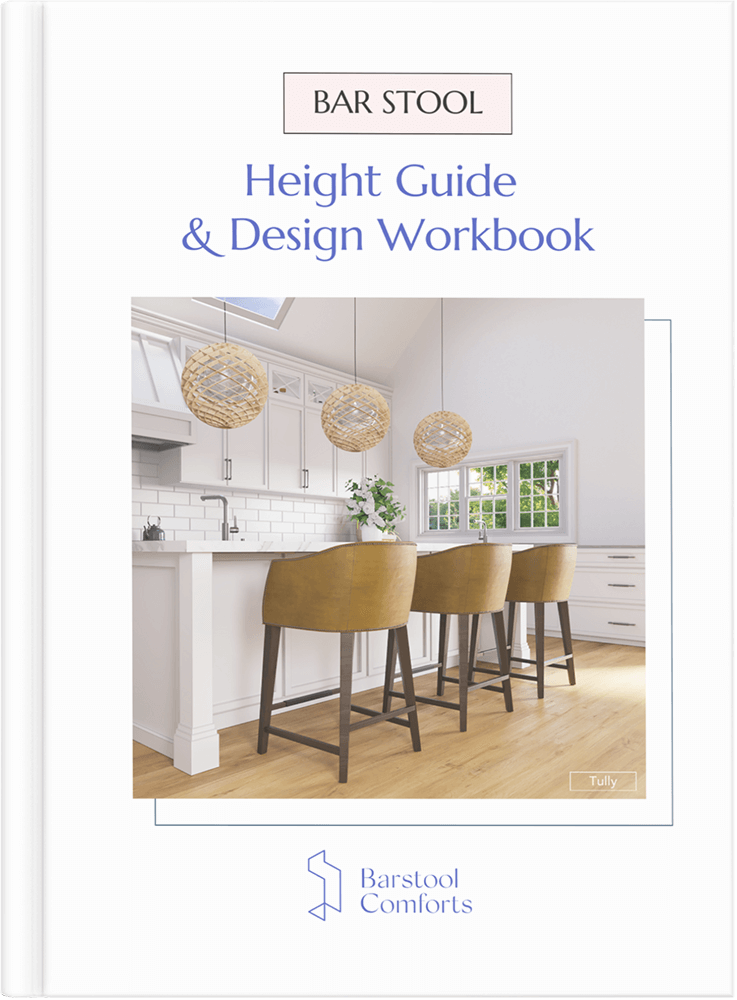Congratulations on finding the perfect stool for your kitchen! You’re now faced with the task of selecting the metal frame color, seat color, and possibly a wood color, depending on the stool you’ve chosen.
Choosing colors may seem overwhelming, but it doesn’t have to be. In fact, with a few simple guidelines, it’s easy to select the ideal colors for your stool.
How to pick colors for your stools in 7 steps:
- First, look at the colors in your kitchen.
- Which colors stand out? Let’s contrast.
- Pull colors out of the countertop
- Pull colors from light fixtures
- Pull colors from appliances like stainless steel
- Make sure the stools contrast your counters
- Kitchen Color Schemes
You simply have to ask the right questions. How do we do that? I’ll guide you.
First, look at the colors in your kitchen. Get your pen and paper ready.
- What color are your cabinets? Are they shades of brown, blue, an off-white? Write that down.
- What are the colors in your kitchen island or table? Are there earth tones? Gray? Beige? White? Jet Black?
- What color is your floor? Brown, gray, off-white, white?
- Let’s look at your appliances. Is your fridge stainless steel, black, or another color? What about your dishwasher, microwave, or oven? Jot that down, please.
Now, ask yourself:
- Do I want a kitchen that has a lot of contrast in colors? – or –
- Do I want a kitchen that has similar tones of color?
Which colors stand out? Let’s contrast.
Now that you have all the colors in your kitchen ask yourself: what colors stand out? Let’s take a look at this kitchen:

- The colors of the flowers stand out.
- The chalkboard sign hanging up does.
- The knobs on the oven do.
In this kitchen, the designer decided to take the colors in the chalkboard and oven fixtures and bring them into the metal frame on the stool. It’s a nice contrast against the off-white and sandy colors in the countertop.
Also, notice how the colors in this kitchen form a triangle shape to the eye. This dark charcoal is present at different angles of the room, giving it a sense of balance.

If the designer were to make the metal frame white, there wouldn’t be much contrast. The stools would blend into the countertop, and the whole space would feel drab.
In your kitchen — which colors stick out? What colors don’t? Keep these in mind so that you can create contrast with your stools.
Here’s another kitchen that has balance. Notice the green seat color on the stools and the green wall in the kitchen. They’re at opposite sides, but compliment each other in the room. For example, green and white on the walls, green and white on the stools.

The white color on the metal frame of the stool contrasts beautifully against the medium brown color on the base of the counter.
However, what about the metal frame on the back? It’s similar in color to the top of the counter. Yes, it is, but here it’s not a problem because the backrest isn’t higher than the countertop, so the stool doesn’t get lost.
Here’s a kitchen where the fabric on the stools doesn’t match the colors on the counter, but contrast with the brown tones in the kitchen. If you want to lighten a dark kitchen, I recommend using a lighter color on the stools.

Notice how the color of the metal finish on the stools goes great with the granite countertop.
Contrasting with Shades, Patterns or Textures
Let’s look at one more kitchen that does a great job of balance and contrast without using much color.
Here is a reasonably monochromatic kitchen. This type of kitchen primarily uses one color with different shades, patterns or textures to create contrast.
Here, you’ll notice a lot of the same shades of grays, some darker and some lighter. The base and cabinets are an off-white which creates contrast.

Notice how the legs on the stool have a lot of contrast to the base in the countertop, making the stools stand out even in a monochromatic kitchen.
Patterns are commonly mixed, but small, subdued patterns work well with large patterns on window treatments for example.
Alternatively, you can add large stripes on curtains with and have your barstools upholstered with tiny stripes or small checks. Here’s an example:
It’s not recommended to use a large pattern on a window treatment against a large pattern on a stool seat. For example, large stripes on a window treatment and large stripes on a stool seat unless it’s the same fabric pattern.
Here’s another kitchen with monochromatic roots, but with a few splashes of red:

You could essentially design everything in the same tones, but have little pops of color throughout the room, whether it be a red bowl or a picture frame. It’s a way to change your color if you get tired of it without spending much money and keeping your kitchen looking fresh.
Contrasting with Wood in a Kitchen
If you have wood accents in your kitchen, the same rules apply. You can use all one color on the stool or a two-toned combination (seat is one color, backs, and legs another). Moreover, the same principle would apply as in choosing padded seats (contrasting light and dark).

Pull colors out of the countertop.
When picking colors, it’s a good idea to start pulling some colors out of your countertop and applying some of those to your stools, whether it be in the metal finish or fabric.
Pull colors from light fixtures.
Sometimes a pendant light fixture above the center of the island or counter can be matched to the style of the stool (metal pendant – metal stool).
Ornate pendant light fixtures can match an ornate stool. Likewise, minimally designed light fixtures can go well with minimally designed barstools.
Pull colors from appliances like stainless steel.
If the kitchen has a lot of stainless appliances, stainless finishes on stools can be a nice addition to the room as long as they are not too close together. Here are a few examples:

Too much stainless will look industrial, if that’s what you like. For example:

However, stainless can be warmed up with extra wood tones in the room:

Make sure the stools contrast your counters.
Floors under the stool should be contrasting to the stool.
A wood or metal stool should not be the same shade or color as the floor. If the color of the stool is the same color as the floor, it could look too blended and not contrasting.
Here are examples of kitchens that have a good contrast between the floor and the stools:

Kitchen Color Schemes
We went over selecting colors and how to contrast with colors and patterns. Now, I want to leave you with some color schemes that I find work in today’s modern world but are also a little out of the box.

I’m sure you can find a color scheme of your own that works just as well. Your kitchen is a reflection of you and your personality.
What colors make you feel at home? What colors make you feel comfortable? What colors are inspiring to you?
What Color Bar Stools Work Best with White Cabinets?
White cabinets are clean, airy, and incredibly forgiving. If you want contrast, darker metals like matte black, charcoal, or dark bronze bring shape back into the room and help your stools stand out.
Looking for a softer look? Warm wood tones, oatmeal fabrics, and brushed stainless finishes create an inviting, modern vibe. White-on-white can work—but choose a stool with a distinct silhouette so it doesn’t disappear into the cabinetry.
Bar Stools for Dark Cabinets (Espresso, Walnut, or Deep Stains)
Dark cabinetry makes a statement, so your stools should lighten the mood a bit. Creams, beiges, light grays, and soft textured fabrics help break up the depth.
If you love a dramatic look, go for rich colors like hunter green, navy, or deep rust—just be sure the frame contrasts the cabinet tone so the stools don’t visually sink into the space.
What Color Bar Stools Pair Well with a Black Kitchen Island?
A black island is bold and effortless. To avoid a heavy feel, bring in lighter or warmer elements—white, camel, natural wood, brushed brass, or medium oak finishes.
If you prefer an ultra-modern aesthetic, keep the palette monochromatic: black frames with charcoal, gray, or patterned seats add interest without losing the sleekness.
Bar Stools for Dark Brown Cabinets
Dark brown cabinetry already adds warmth, so your stools can either brighten the space or echo the richness. Light neutrals—sand, ivory, flax, or light gray—keep things airy.
If you want something more grounded, consider two-toned stools: metal frames in black or bronze paired with a medium-brown or tan seat. The key is maintaining contrast with the cabinet color so everything feels balanced rather than heavy.
Questions? Comments?
If you have any questions on anything in this article or need some help picking your bar stool colors, I’m here to help!
You’re also welcome to send in pictures of your kitchen, home bar, or other space where your stools are going. I’ve been color coordinating for the past 25 years and love it.
Kind regards,
Deborah




